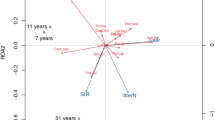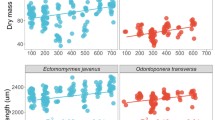Abstract
The eastern hive bee Apis cerana is a major honeybee species in Asia providing numerous ecosystem services. Understanding how much the honeybees depend on natural and human-influenced plants and landscapes in different climates is important could contribute to evaluate how wild honeybees use food resources and to measure the ecosystem services. We investigated the effects of land use and climate changes on stable nitrogen and carbon isotope ratios in wild populations of A. cerana. In populations from 139 individual sites throughout Japan, we measured nitrogen (δ15N) and carbon (δ13C) stable isotope ratios and analyzed the effects of land use and climate. Our results showed that forested areas and annual precipitation had significant effects on δ15N, and that paddy fields and urban areas had significant effects on δ13C. These results suggest that A. cerana sensibly uses available food resources in the various environments and that stable nitrogen and carbon isotope ratios clearly reflect the effects of land use and climate changes on the populations of A. cerana. Thus, stable nitrogen and carbon isotope ratios in A. cerana, which widely distributes in Asia, can be used as indicators of the environments, such as land use and climate, of an area within its foraging range.

Similar content being viewed by others
References
Anderson LM, Dynes TM, Berry JA, Delaplane KS, McCormick LL, Brosi BJ (2014) Distinguishing feral and managed honeybees (Apis mellifera) using stable carbon isotopes. Apidologie 45:653–663. doi:10.1007/s13592-014-0283-4
Boutton TW, Cameron GN, Smith BN (1978) Insect herbivory on C3 and C4 grasses. Oecologia 36:21–32. doi:10.1007/bf00344568
Choi WJ, Han GH, Lee SM, Lee GT, Yoon KS, Choi SM, Ro HM (2007) Impact of land-use types on nitrate concentration and delta N-15 in unconfined groundwater in rural areas of Korea. Agric Ecosyst Environ 120:259–268. doi:10.1016/j.agee.2006.10.002
Corlett RT (2001) Pollination in a degraded tropical landscape: a Hong Kong case study. J Trop Ecol 17:155–161. doi:10.1017/s0266467401001109
Cormie AB, Schwarcz HP (1996) Effects of climate on deer bone delta N-15 and delta C-13: lack of precipitation effects on delta N-15 for animals consuming low amounts of C-4 plants. Geochim Cosmochim Acta 60:4161–4166. doi:10.1016/s0016-7037(96)00251-7
Dafni A, Kevan PG, Husband BC (2005) Practical pollination biology. Practical pollination biology. Enviroquest Ltd, Cambridge
Dyer FC, Seeley TD (1991) Dance dialects and foraging range in three Asian honey bee species. Behav Ecol Sociobiol 28:227–233
Fang Y et al (2011) Nitrogen deposition and forest nitrogen cycling along an urban–rural transect in southern China. Glob Change Biol 17:872–885
Fry B, Joern A, Parker PL (1978) Grasshopper food web analysis: use of carbon isotope ratios to examine feeding relationships among terrestrial herbivores. Ecology 59:498–506. doi:10.2307/1936580
Gibb H, Cunningham SA (2011) Habitat contrasts reveal a shift in the trophic position of ant assemblages. J Anim Ecol 80:119–127. doi:10.1111/j.1365-2656.2010.01747.x
Heaton TH, Vogel JC, von La Chevallerie G, Collett G (1986) Climatic influence on the isotopic composition of bone nitrogen. Nature 322:822–823
Hyodo F (2015) Use of stable carbon and nitrogen isotopes in insect trophic ecology. Entomol Sci 18:295–312. doi:10.1111/ens.12128
Hyodo F, Matsumoto T, Takematsu Y, Kamoi T, Fukuda D, Nakagawa M, Itioka T (2010) The structure of a food web in a tropical rain forest in Malaysia based on carbon and nitrogen stable isotope ratios. J Trop Ecol 26:205–214. doi:10.1017/s0266467409990502
Ikeda H, Kubota K, Kagawa A, Sota T (2010) Diverse diet compositions among harpaline ground beetle species revealed by mixing model analyses of stable isotope ratios. Ecol Entomol 35:307–316. doi:10.1111/j.1365-2311.2010.01182.x
Jung K, Gebauer G, Gehre M, Hofmann D, Weißflog L, Schüürmann G (1997) Anthropogenic impacts on natural nitrogen isotope variations in Pinus sylvestris stands in an industrially polluted area. Environ Pollut 97:175–181
Kaown D, Koh DC, Mayer B, Lee KK (2009) Identification of nitrate and sulfate sources in groundwater using dual stable isotope approaches for an agricultural area with different land use (Chuncheon, mid-eastern Korea). Agric Ecosyst Environ 132:223–231. doi:10.1016/j.agee.2009.04.004
Kim H, Kaown D, Mayer B, Lee JY, Hyun Y, Lee KK (2015) Identifying the sources of nitrate contamination of groundwater in an agricultural area (Haean basin, Korea) using isotope and microbial community analyses. Sci Total Environ 533:566–575. doi:10.1016/j.scitotenv.2015.06.080
Klein AM, Vaissiere BE, Cane JH, Steffan-Dewenter I, Cunningham SA, Kremen C, Tscharntke T (2007) Importance of pollinators in changing landscapes for world crops. Proc R Soc Lond B 274:303–313
Layman CA et al (2012) Applying stable isotopes to examine food-web structure: an overview of analytical tools. Biol Rev 87:545–562. doi:10.1111/j.1469-185X.2011.00208.x
Levin I, Kromer B, Schmidt M, Sartorius H (2003) A novel approach for independent budgeting of fossil fuel CO2 over Europe by 14CO2 observations. Geophys Res Lett 30
Lichtfouse E, Lichtfouse M, Jaffrézic A (2003) δ13C values of grasses as a novel indicator of pollution by fossil-fuel-derived greenhouse gas CO2 in urban areas. Environ Sci Technol 37:87–89. doi:10.1021/es025979y
Marino BD, McElroy MB (1991) Isotopic composition of atmospheric CO2 inferred from carbon in C4 plant cellulose. Nature 349:127–131
Mariotti A, Germon JC, Hubert P, Kaiser P, Letolle R, Tardieux A, Tardieux P (1981) Experimental determination of nitrogen kinetic isotope fractionation: some principles; illustration for the denitrification and nitrification processes. Plant Soil 62:413–430. doi:10.1007/bf02374138
Mariotti A, Leclerc A, Germon J (1982) Nitrogen isotope fractionation associated with the NO2− → N2O step of denitrification in soils. Can J Soil Sci 62:227–241
Martins DJ, Collins SC, Congdon C, Pierce NE (2013) Association between the African lycaenid, Anthene usamba, and an obligate acacia ant, Crematogaster mimosae. Biol J Linn Soc 109:302–312. doi:10.1111/bij.12037
Michener CD (2007) The bees of the world, 2nd edn. The Johns Hopkins University Press, Baltimore
Nagamitsu T, Inoue T (1999) Differences in pollen sources of Apis cerana and Apis mellifera at a primary beech forest in central Japan. J Apic Res 38:71–78
Oldroyd BP, Wongsiri S (2006) Asian honey bees: biology, conservation, and human interactions. Harvard University Press, Cambridge
O’Leary MH (1988) Carbon isotopes in photosynthesis. BioScience 38:328–336. doi:10.2307/1310735
Ostrom PH, ColungaGarcia M, Gage SH (1997) Establishing pathways of energy flow for insect predators using stable isotope ratios: field and laboratory evidence. Oecologia 109:108–113. doi:10.1007/s004420050064
Pataki DE, Bush SE, Ehleringer JR, Flanagan L, Ehleringer J, Pataki D (2005) Stable isotopes as a tool in urban ecology. In: Stable isotopes and biosphere-atmosphere interactions: processes and biological controls, pp 199–216
Pu DQ et al (2014) Flower-visiting insects and their potential impact on transgene flow in rice. J Appl Ecol 51:1357–1365. doi:10.1111/1365-2664.12299
R Development Core Team (2015) R, a language and environment for statistical computing. R Foundation for Statistical Computing, Vienna
Sasaki M (1999) Wonders of the Japanese honeybee—biology of northernmost Apis cerana -. Kaiyusha, Tokyo
Schallhart N, Wallinger C, Juen A, Traugott M (2009) Dispersal abilities of adult click beetles in arable land revealed by analysis of carbon stable isotopes. Agric For Entomol 11:333–339. doi:10.1111/j.1461-9563.2009.00428.x
Sugiura S, Ikeda H (2014) Keratin decomposition by trogid beetles: evidence from a feeding experiment and stable isotope analysis. Naturwissenschaften 101:187–196. doi:10.1007/s00114-013-1137-z
Taki H, Okabe K, Yamaura Y, Matsuura T, Sueyoshi M, Makino S, Maeto K (2010) Effects of landscape metrics on Apis and non-Apis pollinators and seed set in common buckwheat. Basic Appl Ecol 11:594–602. doi:10.1016/j.baae.2010.08.004
Taki H, Yamaura Y, Okabe K, Maeto K (2011) Plantation versus natural forest: matrix quality determines pollinator abundance in crop fields. Sci Rep 1:132. doi:10.1038/srep00132
Tillberg CV, Holway DA, LeBrun EG, Suarez AV (2007) Trophic ecology of invasive Argentine ants in their native and introduced ranges. Proc Natl Acad Sci USA 104:20856–20861. doi:10.1073/pnas.0706903105
Wilder SM, Holway DA, Suarez AV, LeBrun EG, Eubanks MD (2011) Intercontinental differences in resource use reveal the importance of mutualisms in fire ant invasions. Proc Natl Acad Sci USA 108:20639–20644. doi:10.1073/pnas.1115263108
Winston ML (1991) The biology of the honey bee. Harvard University Press, Cambridge
Woodcock P, Edwards DP, Newton RJ, Khen CV, Bottrell SH, Hamer KC (2013) Impacts of intensive logging on the trophic organisation of ant communities in a biodiversity hotspot. PLoS One. doi:10.1371/journal.pone.0060756
Yamaura Y, Amano T, Kusumoto Y, Nagata H, Okabe K (2011) Climate and topography drives macroscale biodiversity through land-use change in a human-dominated world. Oikos 120:427–451. doi:10.1111/j.1600-0706.2010.18764.x
Zhang Y, Li FD, Zhang QY, Li J, Liu Q (2014) Tracing nitrate pollution sources and transformation in surface- and ground-waters using environmental isotopes. Sci Total Environ 490:213–222. doi:10.1016/j.scitotenv.2014.05.004
Acknowledgments
We thank the members of Hachi-channel, J. Fujie, K. Goka, H. Goto, L. G. Kawaguchi, T. Matsumura, M. Mizota, M. Nomura, S. Sato, M Sueyoshi, K. Tabuchi, A. Ueda, K. Yamagishi, T. Yokoi, and K. Watanabe, for assisting with our field sampling and K. Takano and S Kitajima for assisting with our laboratory work. This study was supported by JSPS KAKENHI Grant Number 25740051 and Global Environment Research Funds S-9 and 5-1407 from the Ministry of the Environment, Japan.
Author contributions
HT, HI, SS, and KO conceived and designed the study. HT, SS, KM, and KO collected the data. HI and MY assembled the stable isotope data and the environmental variables, respectively. TN analyzed the data. HT, HI, and TN wrote the draft, and all parties commented on and edited the article.
Author information
Authors and Affiliations
Corresponding author
Additional information
Communicated by Eckehard Brockerhoff, Hervé Jactel and Ian Thompson.
This is part of the special issue on ‘Forest biodiversity and ecosystem services’.
Electronic supplementary material
Below is the link to the electronic supplementary material.
Rights and permissions
About this article
Cite this article
Taki, H., Ikeda, H., Nagamitsu, T. et al. Stable nitrogen and carbon isotope ratios in wild native honeybees: the influence of land use and climate. Biodivers Conserv 26, 3157–3166 (2017). https://doi.org/10.1007/s10531-016-1114-x
Received:
Revised:
Accepted:
Published:
Issue Date:
DOI: https://doi.org/10.1007/s10531-016-1114-x




